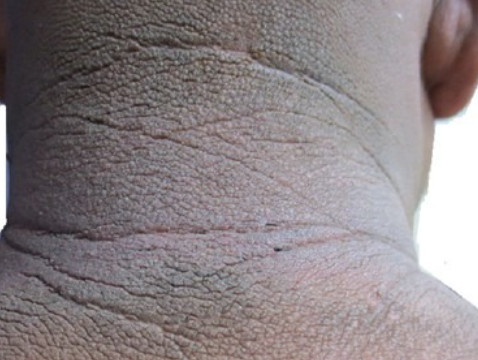Acanthosis nigricans is diagnosed clinically and histopathology may be done to confirm the diagnosis.
The main treatment is the treatment of the underlying condition.
What to investigate for?
Investigations for associated diseases
- Calculate BMI : to detect obesity.
- Overweight adults and children should be investigated for:
- Fasting insulin : elevated in patients with insulin resistance.
- Fasting glucose and Hemoglobin A1c.
- HOMA-IR
- Fasting lipid profile.
- Alanine aminotransferase: For fatty liver evaluation.
- If malignant acanthosis nigricans is suspected:
- Fecal occult blood testing, endoscopy, imaging, tumor markers as CA 125 level and serum carcinoembryonic antigen (CEA).

Treatment options
General tips
- Management of the underlying condition.
- In familial AN or AN not associated with an underlying condition, treatment is aimed at improving the cosmetic appearance.
- Weight loss and exercise have shown to improve obesity associated type.
- HAIR-AN syndrome may be treated with oral contraceptives and metformin.
Medical treatment
Topical
- Topical retinoid: intermittent tretinoin application is needed to maintain improved status 2 months, it improves hyperkeratosis, but not hyperpigmentation.
- Retinoic acid ointment 0.1% twice daily.
- Ammonium lactate 12% cream twice daily and tretinoin 0.05% cream nightly.
- Tazarotene 0.05% : once daily
- Topical 0.1% adapalene gel
- Urea, salicylic acid
- Kligman’s bleaching formula: tretinoin 0.05%, hydroquinone 4%; fuocinolone 0.01%) nightly with daily photoprotection.
- Trichloroacetic acid (TCA) 15% peel sessions: once per week for a month.*
- Calcipotriol: twice daily for mixed type.
Systemic
- Oral retinoids
- Isotretinoin: 2–3 mg/kg/day for 4 months
- Acitretin: 0.8mg/kg with 0.4 mg/kg/day maintenance.
- Metformin :500 mg metformin thrice daily
- Octreotide: 50 µg subq TID
- Fish oil : 20 g/day for 6 months.
- Acipimox : 250 mg TID.
- Melatonin : 3 mg/day*
physical treatment options
- PUVA.
- Laser dermabrasion with long-pulsed alexandrite laser:expensive and may lead to postinflammatory hyperpigmentation.
#Acanthosis Nigricans #Acanthosis nigricans investigatios #Acanthosis nigricans management #Acanthosis Nigricans treatment #Malignant acanthosis nigricans #metformin